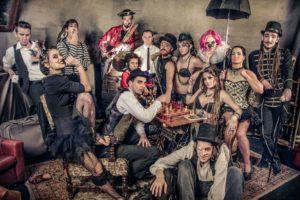Fodor's Expert Review Országház
The most visible symbol of Budapest's left bank is the huge neo-Gothic Parliament, mirrored in the Danube much the way Britain's Parliament is reflected in the Thames. It was designed by the Hungarian architect Imre Steindl and built by 1,000 workers between 1885 and 1902. The grace and dignity of its long facade and 24 slender towers, with spacious arcades and high windows balancing its vast central dome, lend this living landmark a refreshingly baroque spatial effect. The exterior is lined with 90 statues of great figures from Hungarian history, with corbels ornamented by 242 allegorical statues. Inside are 691 rooms, 10 courtyards, and 29 staircases; some 88 pounds of gold were used for the staircases and halls. These halls are also a gallery of late-19th-century Hungarian art, with frescoes and canvases depicting Hungarian history, starting with Mihály Munkácsy's large painting of the Magyar Conquest of 896.
Parliament's most sacred treasure isn't the Hungarian... READ MORE
The most visible symbol of Budapest's left bank is the huge neo-Gothic Parliament, mirrored in the Danube much the way Britain's Parliament is reflected in the Thames. It was designed by the Hungarian architect Imre Steindl and built by 1,000 workers between 1885 and 1902. The grace and dignity of its long facade and 24 slender towers, with spacious arcades and high windows balancing its vast central dome, lend this living landmark a refreshingly baroque spatial effect. The exterior is lined with 90 statues of great figures from Hungarian history, with corbels ornamented by 242 allegorical statues. Inside are 691 rooms, 10 courtyards, and 29 staircases; some 88 pounds of gold were used for the staircases and halls. These halls are also a gallery of late-19th-century Hungarian art, with frescoes and canvases depicting Hungarian history, starting with Mihály Munkácsy's large painting of the Magyar Conquest of 896.
Parliament's most sacred treasure isn't the Hungarian legislature but rather the Szent Korona (Holy Crown), which reposes with other royal relics under the cupola. The crown sits like a golden soufflé above a Byzantine band of holy scenes in enamel and pearls and other gems. It seems to date from the 12th century, so it could not be the crown that Pope Sylvester II presented to St. Stephen in the year 1000, when he was crowned the first king of Hungary. Nevertheless, it is known as the Crown of St. Stephen and has been regarded—even by communist governments—as the legal symbol of Hungarian sovereignty and unbroken statehood. In 1945 the fleeing Hungarian army handed over the crown and its accompanying regalia to the Americans rather than have them fall into Soviet hands. They were restored to Hungary in 1978.
The only way you can visit the Parliament and see the crown is on one of the daily tours. Lines at the visitor center on the north side of the edifice may be long and tickets are in limited numbers, so it's best to purchase tickets in advance (). A permanent exhibit about the thousand years of Hungarian legislation is available free through the visitor center until 2 pm. Note that Parliament is closed to the public during ceremonial events and when the legislature is in session (usually Monday and Tuesday from late summer to spring).
READ LESS








